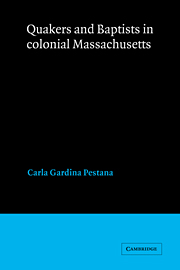1 - The Quaker movement in northeastern Massachusetts
Published online by Cambridge University Press: 22 October 2009
Summary
A Quaker movement emerged in western Salem in 1657-8. Inspired by the message of English radicals, dozens of Salem residents along with a handful of people from other towns joined together to organize an alternative religious community within the confines of New England's leading orthodox colony. If the encouragement of visiting Quakers helped to give meaning to this concerted act of defiance, the participation of loved ones and friends in rural Salem provided support in the face of vehement community and governmental opposition. Converts to the new sect displayed an unprecedented disaffection from the colony's religious establishment, despite the fact that they had been living quietly under it for years. The events in Salem took orthodox observers by surprise.
The colony's mechanisms for dealing with dissent were pushed to the limit during the conflict that ensued but failed to achieve the accustomed results. The dramatic confrontation between English Quaker witnesses and colonial authorities has occupied center stage in accounts of the sect's introduction to New England. However, the creation of an indigenous sectarian enclave was at the heart of the matter for the traveling Quakers who sought to plant the seed of truth in New England. As Bay colony magistrates sent Quaker missionaries to their deaths, all concerned were engaged in a struggle for the allegiances of the populace. A vocal minority identified openly with the martyrs.
On 26 June 1658, thirty people gathered at the house of Nicholas and Hannah Phelps in the less densely populated region of western Salem called the “woods.”
- Type
- Chapter
- Information
- Quakers and Baptists in Colonial Massachusetts , pp. 25 - 43Publisher: Cambridge University PressPrint publication year: 1991



